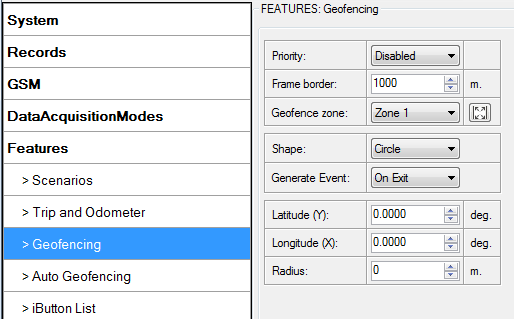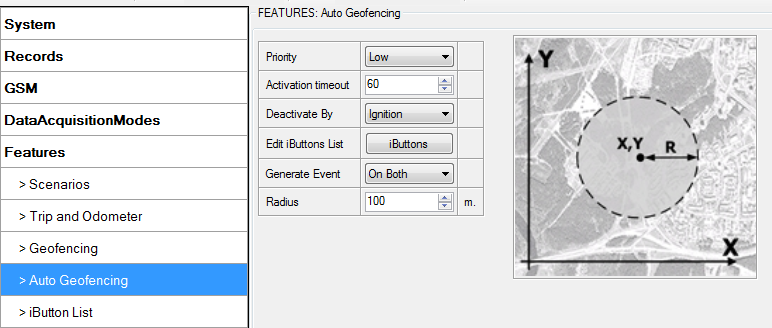FMA202 Features settings
Scenarios settings
Five scenarios are available on FMA202 device. Green driving, Over speeding, Jamming detection, Immobilizer and iButton detect scenarios can be used to manage digital output 1 and digital output 2. A single digital output can be controlled by a few scenarios. However, it is not recommended to configure Immobilizer and other scenarios on the same digital output.
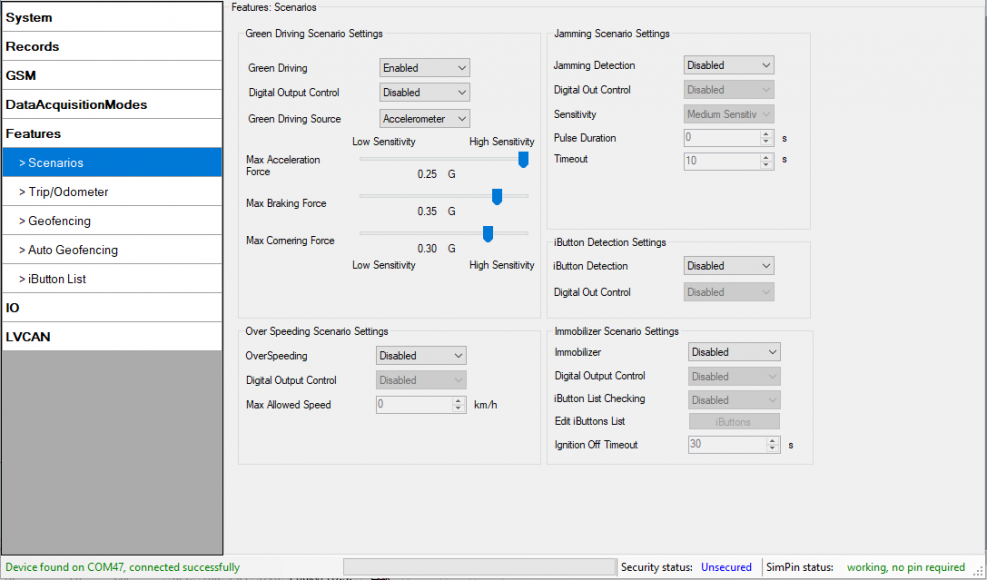
Digital Output (open drain grade) usage in scenarios:
Green Driving
Helps to inspect driver and prevent about harsh driving. Green driving source can be GPS or accelerometer. Scenario continuously monitors: accelerating force, braking force and cornering angles depending on build in accelerometer or depending on GPS. The device inspects driver if needed. Monitoring sensitivity is configurable. The scenario can control DOUT to alert the driver, with, for example, a buzzer or an LED.
To save GPRS traffic Green Driving event will be generated (included into sent records) only when FMA202 measured values are higher than those set in configuration, without additional I/O settings.
To prevent generating false events, harsh acceleration and harsh braking is monitored only when following conditions are fulfilled:
- Ignition is ON (DIN1 = 1)
- Vehicle speed is equal or higher than 10km/h
Harsh cornering is monitored only when following conditions are fulfilled:
- Ignition is ON (DIN1 = 1)
- Vehicle speed is equal or higher than 30km/h
Digital output control:
DOUTX (selected digital output) is ON for:
- 3sec. if detected value is over (0; 30] % from preconfigured allowed value;
- 5sec. if detected value is over (30; 50] % from preconfigured allowed value;
- 7sec. if detected value is over (50; -] % from preconfigured allowed value.
After period of time DOUTX is turned OFF.
Over Speeding
Helps to prevent from exceeding fixed speed and inspects driver if needed. DOUT1 or DOUT2 is controlled by scenario for user needs, to manage buzzer, LED, etc.
Digital output control:
DOUTX (selected digital output) is ON, while vehicle speed exceeds parameter value. DOUTX is activated until current speed decreases below parameter value.
Jamming detection
Radio jamming is the (usually deliberate) transmission of radio signals that disrupt communications by decreasing the signal to noise ratio. When jamming detection is enabled, FMA202 informs (with buzzer or LED, connected to digital output) driver about jamming event.
Digital output control:
DOUTX (selected digital output) is ON, while modem is fixing radio frequency jamming. After jamming is over, DOUTX is deactivated.
When pulse duration and timeout are set to 0:
Pulse duration 0 - device will hold DOUT on all the time while jamming is detected.
Timeout 0 - device will generate event instantly when jamming is detected.
Bandwidth: -100 dBm to -500 dBm
Immobilizer
Vehicle can be used only if iButton is connected. In this scenario iButton list is not used, connect any iButton to pass Immobilizer security. DOUT2 or DOUT1 is controlled by scenario for user needs, to manage buzzer, LED, etc.
Digital output control:
DOUTX (selected digital output) is continuously OFF. DOUTX turns ON if Ignition turns ON (configured Ignition Source = 1). After iButton ID is read (any iButton is attached), DOUTX turns OFF. After iButton identification, ignition can be turned OFF (configured Ignition Source = 0) for no longer than 30 seconds, otherwise immobilizer must be repeated.
iButton detect
If iButton is read, scenario activates configured DOUT for 500 ms. Second activation will be available only when iButton I/O element value goes back to 0, or another iButtob is read.
Trip and Odometer settings
Virtual Odometer
Virtual odometer is used to calculate traveled distance in FMA202 as a separate I/O element. When FMA202 detects movement, it starts counting distance using GNSS signal: every second it checks current location and calculates distance between current and previous point. It keeps adding these intervals until it is time to make a record, then FMA202 records its location and adds odometer value, which is equal to the sum of all distances, measured every second. When record is made, odometer resets to zero and distance calculation starts all over again. Virtual odometer as an I/O element can be also used with Trip.
Trip
Trip customizable feature enables user extended monitoring of performed trips (from engine start at present location to engine stop at arrived location), log their start and stop points, view driven total distance. Event will be generated (included into send records) only when trip starts and finishes. This feature is available on all FMA202 hardware versions without limitations.
| Note: Scenarios and Trip features are activated (DOUTs are activated) only if DIN1 = 1 (ignition is on). |
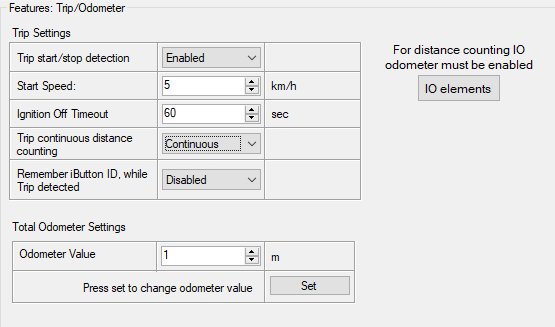
If Trip is enabled following parameters are configurable:
- Start Speed – GPS speed has to be greater than the specified Start Speed in order to detect Trip Start.
- Ignition Off Timeout – timeout to wait if ignition (configured Ignition Source) was off, to detect Trip stop.
- Continuous distance counting – Not or Continuous can be chosen. For this feature I/O Trip distance must be enabled.
- Remember iButton ID – devices remembers connected iButtons id(While trip is detected) and sends it to server along with periodical records.
If I/O Trip distance is enabled and Continuous distance counting variable is set to Continuous, Trip distance is going to be counted continuously (from Trip start to Trip stop). This value is written to I/O Trip distance value field. When Trip is over and next Trip begins, Trip distance value is reset to zero. When the next trip starts counting continuously starts from the beginning again.
If I/O Trip distance is enabled and Continuous Distance Counting variable is set “Not”, then the distance is going to be counted only between every record made. This value is written to I/O Trip distance value field and reset to zero every new record until Trip stops. If later all Trip distance values are summed up manually, the user gets the distance driven during the whole period of the Trip.
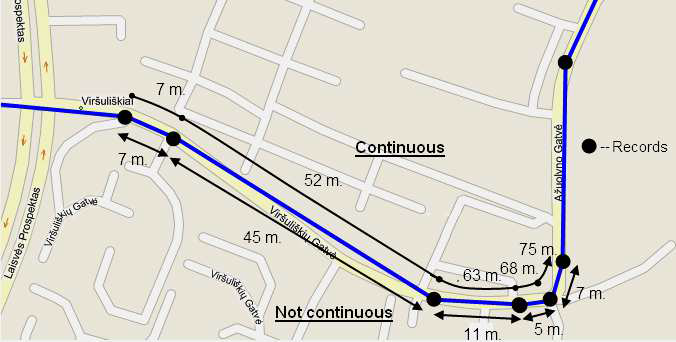
Continuous odometer calculates the distance if Total Distance I/O element is enabled. Odometer Value is constantly saved to flash memory every 30 seconds, but counted every second. After power is turned off, odometer value saved in flash does not reset. Start odometer value with can be set using configurator („set“ button) or SMS/GPRS (setparam/getparam) commands. This parameter can not be configured via TCP config. If this value is not set, FMA202 starts counting from 0. Continuous odometer works irrespective of the Trip functionality.
Geofencing settings
Geofence
Geofencing is another feature which is highly customizable and can detect wherever car enters or leaves customized areas.
FMA202 has 5 configurable Geofence zones and it can generate an event when defined Geofence zone border is crossed.
Frame border – frame border is an additional border around Geofence zone. It is additional
area around defined zone used to prevent false event recording when object stops on the border
of the area and because of GNSS errors some records are made inside area and some – outside.
Event is generated only when both borders are crossed. See figure below for details: track 1 is
considered to have entered the area while track 2 is not.
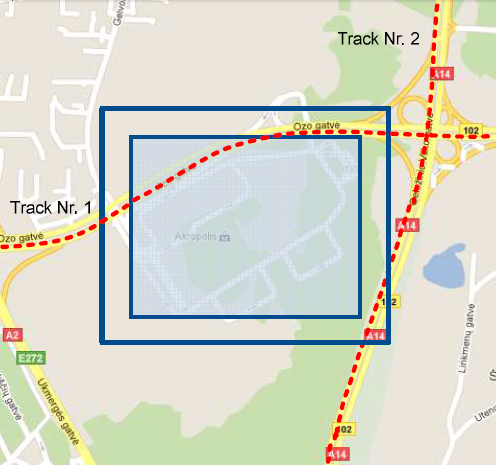
Geofencing option can be configured by following parameters visible in Figure below.
Shape – can be rectangle or circle;
Priority – priority of Geofence event: low, high or panic. These levels define priority of event information sending to server. See I/O element description for more details about priorities;
Generate event (On entrance, On exit, On Both) – choose when record will be generated;
X1 – geofence zone left bottom corner X coordinate (longitude);
Y1 – geofence zone left bottom corner Y coordinate (latitude);
X2 or R – geofence zone upper right corner X coordinate (longitude) or radius of circle when Circular zone is used (radius in meters);
Y2 – geofence zone upper right corner Y coordinate (latitude);
Autogeofence
Auto Geofencing feature if enabled is activated automatically by turning off car ignition. Next time before driving user has to disable Auto Geofencing with iButton or by turning on car ignition. In case of theft car leaves Auto Geofencing zone without authorization high priority record to AVL application is sent automatically.
AutoGeofencing settings
AutoGeofence – the last known position after movement = off. If your car’s being taken away – you can be notified. The shape and size of the geofence zones are parameters. When object will leave geofence zone device will trigger an asynchronous message.
AutoGeofencing option can be configured by following parameters visible in Figure below.
Activation TMO – Time period before Geofence is activated after vehicle stops.
Deactivate By:
- Ignition – If ignition (configured Ignition Source) becomes high it will disable AutoGeofenze Zone.
- iButton – if iButton is attached it will disable AutoGeofence Zone. Edit iButton List – if list is not empty, attached iButton is tested against an iButton list, if match is found AutoGeofence zone is disabled.
Priority – Priority of generated event, which will be applied to saved record.
Exit Event – Event generation on Geofence exit.
On Both – Event generation on Geofence exit.
Note that AutoGeofencing does not require entering coordinates, instead it requires GNSS visibility. If vehicle stopped and activation timeout has passed, an AutoGeofence will be created around vehicle’s last position with set Radius value. AutoGeofence event generation works the same as Geofencing mentioned above.

